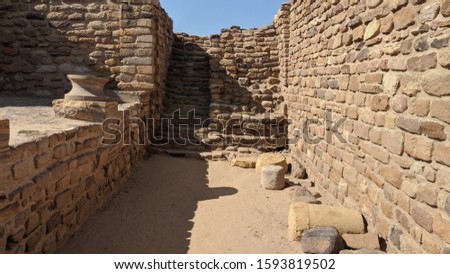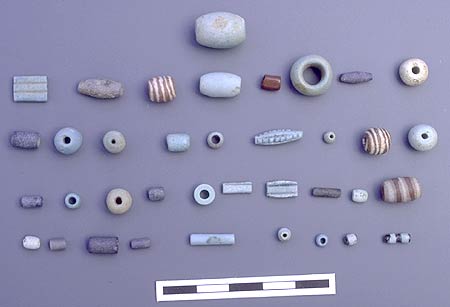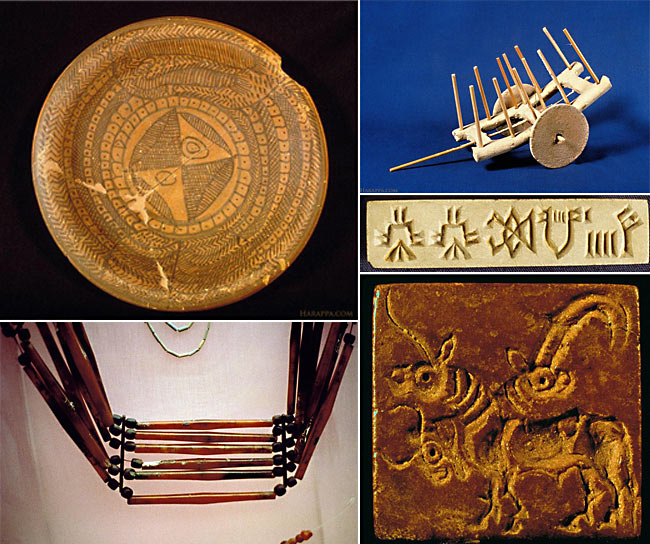Introduction to the history of Harappa
Harappa was one of the many cities like Dhola-vira, Ropar, Mehrgarh, Lothal, Kalibangan, and Rakhigarhi, that developed in the Indus Valley region. The Indus Valley region, is roughly the present Punjab Pakistan and Gujarat regions, around the Indus river. This civilization is one of the most ancient known civilizations with a prospering urban culture, along with Egypt and Mesopotamia.
Out of about 100 ancient towns and villages, the largest excavated cities are Mohenjo-daro and Harappa, and historians have connected the magnitude of these two areas with a capital-like centralization. Harappa’s ruins were proclaimed World Heritage Site by the UNESCO, in 1980.

Architecture
The Harappan civlilization is remembered in history for its incredible city-planning. The main streets are found to be about 45 feet wide, with an extensive and well-planned sewage system that was connected to every house and street. The houses had a connected “bathing house” which, too, was well arranged with the drainage. Stilts were made in the covered drains to allow regular inspection!
In the city of Mohenjo-daro a grand bathing pool has been excavated, with efficient water-proofing with asphalt, and “robing areas” or small rooms by the side of the pools. Some historians believe that the pool and the bathing ritual had an ancient, religious character.
The Harappan cities are strikingly uniform and planned, almost like the modern city planning. Its greatest features are the brick houses, sewage systems, terracotta artefacts, weightage systems, pottery and seals. Massive structures and walls were built for control mechanism, taxation uniformity and military defense.
Crafts and artefacts of Harappan culture
The history of the Harappan civilization shows interesting pottery, jewelry and ornaments made in different manufacturing centers. For example:
Bangles: Harappan crafts in ornaments consisted of headgears, necklaces and bangle. Bangles, worn on the upper and lower arm, were made out of beads, terracotta and shells. These have been found in figurines in the burials.
Lapis Lazuli: Dated to 7570 BCE, artifacts made from lapiz lazuli have been found at Bhirrana, an ancient site of the Indus Valley civilization. There are evidences of its import from Afghanistan, and was highly values by the Indus Valley people. Beads made from these have been found in the Neolithic burials in Mehrgarh, the Caucasus and Mauritania.

Ancient Religions?
Harappan excavations have also located numerous terracotta toys, sculptures and seals or stamps. The large number of animal-motifs on these artefacts have raised the question of the existence of a mythological reference. The most debated in history, of these motifs are the fire-alter, and the image of the unicorn.
Alongside, a figure appears, seated in the ‘yogic’ positions, who is surrounded by animals like the tiger, ‘hill-goat’ , the rhinoceros, and the buffalo, and is believed to perhaps have a semi-divine figure. More strikingly, this figure is connected to the ‘proto- shiva seal’ or the image of the Pasupati, or the lord of the cattle-animals, and may have symbolised the divine figure’s command over all animals.

Global networks through trade
The Indus Valley civilization had a diverse craft production, like pottery and ornaments. Craft-centres like Mehrgarh, were centres for bangle making, from shells and terra cotta beads. The seals were made from steatite, a form of talc and have images of various animals. These seals were used as stamps on official letters, documents, or exports.
The Harappan civilization is also known in history for its flourishing trade within and beyond boundaries. Gold is known to be imported from southern India and Afghanistan. Copper was imported from Afghanistan or northwest India, and the famous lapiz lazuli stone, from Afghanistan. Also, turquoise was bought from Iran or Persia.

Read more:














































